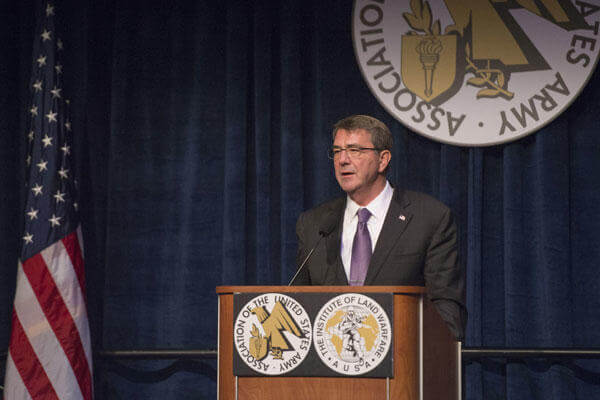U.S. Army leaders will meet this week at the annual AUSA conference in Washington, D.C., to discuss readiness and modernization challenges as the service stretches to counter threats from Europe to Asia.
The Association of the United States Army's 2016 Meeting and Exposition at the Walter E. Washington Convention Center in Washington, D.C., begins Monday and will feature three days of briefings and forums along with a vast exhibition floor packed with the latest equipment from the defense industry.
This will be the first AUSA for Army Secretary Army Eric Fanning, the former acting Air Force secretary and deputy undersecretary of the Navy.
New Secretary
Fanning, who took over the post in May, had to wait six months for Congress to confirm him as the new Army secretary.
Much of the delay had to do with Sen. Pat Roberts, a Kansas Republican, placing a "hold" on Fanning's nomination so he could get assurances from the Defense Department and the Obama administration that prisoners from the Guantanamo Bay, Cuba, naval base will not be housed in the future at Fort Leavenworth, Kansas.
In one of his first higher-profile moves, Fanning in August launched a new Rapid Capabilities Office to expedite critical technologies to the field in an effort to counter urgent and emerging threats.
Fanning is scheduled to speak at show's opening ceremony on Monday, as well as during a town hall with senior leaders including Army Chief of Staff Gen. Mark Milley at a family forum on Wednesday.
Quieter Chief
Milley, who is also scheduled to speak at a luncheon on Tuesday, has taken on a quieter demeanor since taking over as chief in August 2015.
In his early days in the role, Milley wasn't shy about speaking his mind, especially when it came criticizing the Army's Modular Handgun System effort. In March, for example, Milley said that if he had his way, he'd abandon the bureaucratic acquisition effort and personally select the service's next pistol.
The Army launched its long-awaited XM17 MHS competition in late August 2015 to replace its Cold War-era M9 9mm pistol. One of the major goals of the effort is to adopt a pistol chambered for a more potent round than the current 9mm. The U.S. military replaced the .45-caliber 1911 pistol with the M9 in 1985 and began using the 9mm NATO round at that time.
The Army has been tight-lipped about the competition, but the service made headlines just last month when it dropped Smith & Wesson from the competition.
Milley has lately been more reserved -- a stance that may or may not have been related to the Army's recent decision to close this year's Maneuver Conference at Fort Benning, Georgia, to the media so leaders could discuss potential threats from Russia.
In addition to discussions about the threats in Europe, Army leaders on Wednesday will participate in a forum called "Fight Tonight with the Army We Have: Generating, Sustaining, and Applying Army and Joint Readiness in the Pacific Theater."
Guns to Trucks
The defense industry always plays a significant role at the show.
Giant defense contractors and smaller subcontractors will blanket the halls of the convention center to display everything from aircraft and combat vehicles to firearms and munitions to camouflage netting and uniforms.
Truck-maker Oshkosh Corp. will display its Joint Light Tactical Vehicle the Army and the Marine Corps selected to replace a large portion of U.S. Military's Humvee fleet.
The Army recently placed a $42 million order for 130 more JLTVs by November 2017. This is the third order under the original contract. The service awarded Oshkosh a $6.7 billion contract in August 2015 to build the first 17,000 production models of the JLTV. It placed a second order of $243 million in March 2016 for 657 JLTVs.
The work could eventually be worth some $30 billion, as the Army and Marine Corps plan to buy nearly 55,000 of the combat vehicles, including 49,100 for the Army and 5,500 for the Corps, to replace about a third of the Humvee fleets.
Future Helo
Textron Co.'s Bell helicopter unit on Monday is scheduled to hold a discussion at its booth on the exhibit floor about the progress of its V-280 Valor tiltrotor program and the just-announced V-247 Vigilant unmanned aerial system.
Bell will also have a V-280 virtual reality booth, so participants can put on an Oculus headset and experience the aircraft in the VR realm.
Textron Systems is slated to unveil a new ground control stations for UAS and other unmanned systems. The smaller, more powerful station will be able to operate many different kinds of unmanned vehicles and help cut down on the personnel and systems it takes to make UAS operations a reality, Textron officials maintain.
Raytheon Co.'s Intelligence, Information and Services unit also plans to demonstrate how to exploit vulnerabilities of a drone and, more importantly, how to deploy the technology against cyber threats.
--Matthew Cox can be reached at matthew.cox@military.com.



























